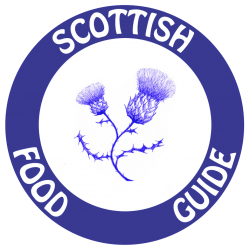The world food system is not in good shape. Where there’s determination and a driving force, it can be repaired and there are many who give me hope, not least the fabulous Scottish Food Guide members, but there is much needing done.
Free Trade in food can create nightmare scenarios, for example the Irish potato famine tragedy was exacerbated by laissez-faire economics, land ownership and mono-cropping. More recently, at Slow Food Terra Madre one year, there was the heart-breaking rendition of a mother from Mali who lost children through starvation when her government forced her to get rid of her vegetables in favour of cotton for export to EU. Food security is a powerful tool in fighting poverty, climate concerns and pollution.

I am as enthusiastic as the next person when Seville oranges are in season for marmalade or the wonderful Sicilian lemons appear but Dutch tomatoes or Egyptian potatoes?…no thanks. Much of our food heritage and economy is threatened by cheap – often tasteless – imports. Clyde valley’s microclimate was once home to dozens of tomato growers, Epicure tatties were cultivated across Ayrshire, Scotland had dozens of apple varieties and there were native breeds for every region. Trade can be positive but not when we produce these foods ourselves and enjoy the thrill of the seasons as they are harvested, be it fruit or vegetables, fish or meat.

For every food has its season and many consumers have sadly lost that connection in their rush to just-in-time supermarket deliveries…until the system cracks as it did so spectacularly during covid. We rediscovered local shops and cheesemakers, helpful butchers and self-employed fishermen, many bereft of their restaurant customers or export markets, selling their produce from quaysides, delivery vans and veg boxes. Thankfully some consumers appreciate the value of food security – you are probably among them – but many reverted to buying unnecessary imports that travelled the world using fuel, creating unnecessary wastage and often causing environmental damage in its place of origin such as almond, palm oil and soy, feedlots and other intensive agriculture regimes.
On a recent trip through Denmark, Germany and Holland, I was horrified at the continual stream of juggernauts thundering by, transporting food, criss-crossing the landscape: both chilled goods in colossal refrigerated units and ventilated trucks loaded with thousands of stressed pigs from Denmark to Germany. Surely there are better ways to feed our nations? We have it in our power to feed ourselves substantially more locally, all year round, and in the interests of health, peak oil, emissions and excessive packaging, isn’t it time for a re-think? We are so disconnected from food; we need to appreciate our farmers and the nuances of the various food production methods.

In Holland, Dutch dairy farmers are protesting by flying flags along roadside farmlands. They are under threat from the government who are taking steps to literally shut down thousands of dairies accused of polluting the canals. Granted there may well be some more industrial than regenerative that need addressed however the government make no such distinction and are devastating families and livelihoods with their allegations and actions.

We witnessed low-density groups of ruminants out grazing as nature intended, creating delicious produce and enhancing biodiversity. Farmers say this prime farming land is wanted for housing developments and urban spread. The fight isn’t over.

Interestingly oft-maligned sheep work wonders on the dikes across northern Holland. Recognised as stabilising the land and strengthening the soil structure with their tight grazing, light trampling and poo-ing, they are appreciated and visible on every embankment. Texel is the local breed and when their days of dike maintenance are done they will make a good hot pot.

Back in Scotland, we need to tackle our farm to fork and fish know-how and I don’t have all the answers but I am on the case. Junk food sold at tills and fuel stations doesn’t help any more than the Food Standards’ misguided Eatwell Guide. From the Health Education Board (as it was then) in the 80’s advocating chicken, and look where that’s got us with industrialised poultry, to the reformulation of processed foods, we’re doomed as Fraser would say! Perhaps we need to ask those who provide our local produce what’s in season then shout it out in schools, “Look, this is what’s available this month for the menu.” Then there’s wild food that hits the headlines for the wrong reasons. Åland served cormorant pizza when they wanted to reduce their pesky bird population so perhaps it’s time for a little greylag fricassée as an economical, nutritious and tasty alternative.
What’s On at Scottish Food Guide
Every week there are new seasonal offers posted on Scottish Food Guide
from fabulous restaurants & producers
In addition from now through to autumn, we shall be presenting at…
Merlindale Nature Festival & there is also a lovely Merlindale wildflower video on YouTube, for those interested in northern hay meadow flowers.
Outwith Festival at Pittencrieff Park, with a “A celebration and tasting of Scotland’s finest seasonal delights from the kitchen garden, hedgerows and islands.”
Scottish Wild Food Festival talk & workshop on “Rare Heritage Foods on Scotland’s Ark of Taste”
Scottish Smallholders Festival Cookery Theatre sessions & talks
…and hosting Cheese Experiences & Wild Inspired workshops to celebrate Slow Cheese & Foraging Fortnight respectively that you can book online on link.
Last but not least, I hope you enjoy my take on electric cars here.
We look forward to meeting many of you, either at events such as the forthcoming Perth Show or on your home turf. Warmest wishes from us both

Next month is harvest time for the heritage grain project at Ardross and more Scottish Food Guide adventures.


